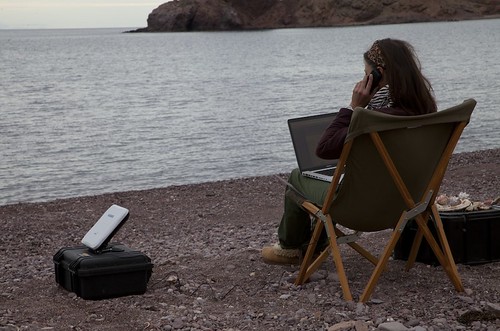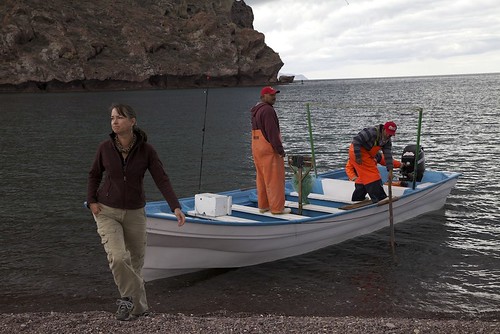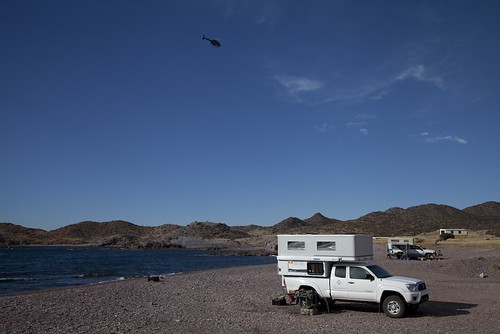
When we took the OCENS BGAN satellite communications kit to a remote beach in Mexico where we planned to celebrate the New Year with friends, we expected to have fun testing it by checking email and news, and maybe making a few phone calls to friends to evaluate the ease of use and reception.
As it turned out, the unit had to prove its value in much more tragic circumstances.
If you’re not yet familiar with the concept, BGAN (Broadband Global Area Network; just say “beegan”) allows both data and telephone communication from virtually anywhere on earth, via a compact portable antenna that links with one of four geosynchronous equatorial-orbit satellites. Roseann and I wanted a system that would allow us to send and receive email, post images and articles on the Web, and make critical telephone calls anywhere we parked the camper. BGAN technology now makes doing so easy and efficient (if not yet exactly cheap) using one’s laptop computer, which communicates with and through the antenna via either a cable or wi-fi connection to access and send data at up to 464 kbps. A separate telephone receiver can be used with the antenna on its own if you don’t need data service (although it will send and receive SMS messages).
We’ve been working with OCENS (“oceans,” for Ocean and Coastal Environmental Sensing) for over a year now—they sponsored the communications area at the 2012 Overland Expo. The company is a comprehensive resource for satellite communication systems, and can equip travelers, explorers, and scientists with BGAN kits, satellite telephones, and other types of equipment and software, either on a purchase or rental basis. Matt at OCENS sent us the latest Hughes 9202 terminal—the smallest Class 2 terminal on the market at barely over eight inches square—along with a Thrane and Thrane Explorer handset. The kit, with a rechargeable lithium-ion battery pack, comes tidily packaged in a Pelican 1450 case. A complete set of instructions for connecting to the Inmarsat satellite system comprises a single laminated card.
Our first morning on the beach in Mexico we made coffee and wandered about catching up with people we hadn’t seen in a long time. There was the usual round of campsite tours as we checked out who’d done what to their Four Wheel Campers or Volkswagen Westfalias or OzTents or FlipPacs. I took some video with the Canon 5D MkII, then moved down to the water’s edge to get some background footage of tidepools and birds. The water was glassy silver; barely a swell tumbled home on the gravel. Brown pelicans skimmed past just millimeters from the surface, defying physics. I heard the sound of an outboard motor, and saw two fishermen heading into the cove, so I set up the camera and got a shot of them traversing the frame. As the camera rolled I looked askance at the boat—a 12-foot, outboard-powered aluminum craft, painted camouflage, that would have been fine on a bass lake but seemed marginal for the Sea of Cortez even in calm weather. The men were obviously weekend sport fishermen; they carried what appeared to be light spinning gear. The two made a few casts in the cove, then motored off to the north.
The afternoon turned windy, as it usually does in winter in the Sea of Cortez, and by dusk a sizable surf was pounding the gravel beach in front of our truck, and whitecaps showed out in the open water. But early the next morning it was calm again when we heard another outboard, and saw three men dressed in foul-weather gear motor up to our beach in a panga—the sturdy and seaworthy fiberglass boat used for decades by Mexican fishermen. Behind the panga they towed a camouflage-painted aluminum boat, which, it developed as we talked with them, they’d found capsized, barely afloat—and empty except for an outboard motor and two fishing rods.

The men pulled the sad little boat up the beach and laid the rods and motor next to it. Meanwhile, I got out the BGAN kit, folded open the square white antenna, and pointed it skyward in the slight southeasterly direction of the Inmarsat equatorial satellite at 98ºW, used by the system in the Americas. Using the signal-strength indicator on the antenna’s LCD screen, it took just a few seconds of nudging to attain a reading over 50, the recommended minimum. As I was adjusting the antenna, Roseann opened her MacBook Pro, which instantly displayed the antenna’s status via a wi-fi connection. In a few more seconds, she was connected to the Web and looking up the phone number for the San Carlos Marina, 40 miles to the south. I plugged in the phone receiver and dialed the number—and within 15 minutes of when the panga landed we had relayed the information to the marina, who contacted the Mexican Coast Guard. Less than an hour later a fixed-wing spotter aircraft and two rigid-hulled inflatable boats (RIBs) were running a grid over the area.
I’d love to report the search found the two men alive and well. Sadly, the RIBs instead recovered the body of Edgar Osantes Loya from the sea, and in the meantime we learned that the two men we first saw in the aluminum boat had in fact picked up a third at their camp north of us. So the situation now involved one dead fisherman and two missing fishermen. The single dim ray of comfort was that the immediate search had at least recovered one body, to offer some closure to the man’s family.

Word got out quickly. By that evening, friends and relatives of the missing men (who were residents of Hermosillo) had stopped by our camp and were driving up and down the coast. The next morning another panga stopped by, and the men reported they’d found a flotation device on a beach several kilometers south of us, along with two sets of footprints. By this time a helicopter had joined the search but was still circling over the sea—standard procedure since if the men were alive they’d be in much worse danger if still in the water. Once more Roseann and I fired up the OCENS unit. This time we had difficulty contacting the marina, and instead called friends in Tucson to have them try directly (which they were able to do).

Several people in our group, along with a friend of the missing men, drove south on an inland track and found the footprints. Chuck Hathcock, a biologist and experienced tracker, followed them for a couple of miles until they disappeared completely in a rocky canyon. Meanwhile I hiked north along the cliff-interrupted coast with binoculars, but saw nothing that day or the next. Nor did other areas of the inland search prove fruitful.
Reviewing what we know of the timeline, it seems likely the boat capsized sometime in the afternoon or evening of the day before it was found. That meant a minimum 12 to 15-hour delay before the search was initiated. According to NOAA data, the water temperature in that region of the Sea of Cortez was around 64 degrees Fahrenheit. Confusion and loss of motor control from hypothermia at that temperature can occur in as little as an hour, with death following in as little as another hour. Thus, unless the other two men made it to shore very quickly, they would have shared the fate of their unfortunate companion.
The day after we returned home, we learned from El Imparcial that the official search had been called off, although relatives were still looking, and there remained hope that the two missing men, Daniel Romero Loya and Noé Loya, were still walking toward San Carlos. We’re continuing to seek news. In the meantime, thanks to the OCENS BGAN unit, at least one family will be able to lay a loved one to rest.

Find out more about satellite communications equipment at OCENS. The complete Hughes 9202 BGAN kit we used costs $2,895; the Thrane handset adds $199. A wide selection of air time plans is available, as well as rental options.
